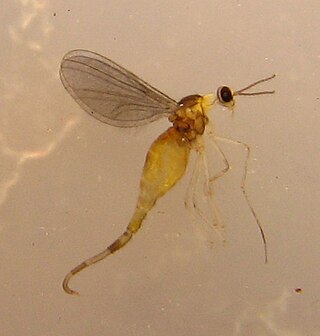Catotricha is a genus of midges in the family Cecidomyiidae. The five described species in Catotricha are found in the holarctic region. This genus was established by British entomologist Frederick Wallace Edwards in 1938.
Resseliella is a genus of gall midges in the family Cecidomyiidae. There are at least 50 described species in Resseliella.
Monardia is a genus of wood midges, insects in the family Cecidomyiidae. The 53 described species in Monardia are grouped into three subgenera.
Micromyinae is a subfamily of wood midges, insects in the family Cecidomyiidae. Its members were formerly included in subfamily Lestremiinae. There are at least 55 genera and more than 650 described species in Micromyinae. All species in this subfamily are mycophageous.
Haplusia is a genus of gall midges and wood midges in the family Cecidomyiidae. There are more than 20 described species in Haplusia.

Winnertzia is a genus of gall midges and wood midges in the family Cecidomyiidae. There are more than 90 described species in Winnertzia.
Anarete is a genus of midges in the family Cecidomyiidae. There are 38 described species. The genus was established by Irish entomologist Alexander Henry Haliday in 1833 and has a cosmopolitan distribution.
Acoenonia is a genus of midges in the family Cecidomyiidae. The six described species are found in the holarctic region. The genus was first described by Arthur Earl Pritchard in 1947.
Anodontoceras is a genus of wood midges in the family Cecidomyiidae. There are three described species. The genus was established by Japanese entomologist Junichi Yukawa in 1967.
Antennardia is a genus of midges in the family Cecidomyiidae. The four described species are found in the Holarctic realm. The genus was first described by Boris Mamaev in 1993, but was subsequently treated as a subgenus of Monardia until being reinstated at the genus level.
Bryomyia is a genus of midges in the family Cecidomyiidae. The six described species are found in the Holarctic and Oriental regions. The genus was first described by Jean-Jacques Kieffer in 1895.
Campylomyza is a genus of midges in the family Cecidomyiidae. The 40 described species are found in the Holarctic, Oriental, Neotropical, and Australasian regions. The genus was first described by German entomologist Johann Wilhelm Meigen in 1818.
Groveriella is a genus of wood midges, insects in the family Cecidomyiidae. The two described species are known only from Europe. The genus was established by Boris Mamaev in 1978.
Neurolyga is a genus of wood midges, insects in the family Cecidomyiidae. The 28 described species occur in the holarctic region. The genus was established by Italian entomologist Camillo Rondani in 1840.
Polyardis is a genus of midges in the family Cecidomyiidae. The ten described species are found in the Holarctic and Australasian realms. The genus was first described by entomologist Arthur Earl Pritchard in 1947.
Pseudoperomyia is a genus of midges in the family Cecidomyiidae. The 29 described species are found in the Palearctic and the Indomalayan regions. The genus was first described by Mathias Jaschhof and Heikki Hippa in 1999.
Pteridomyia is a genus of midges in the family Cecidomyiidae. The four described species are all found in Australasia. The genus was first described by Mathias Jaschhof in 2003.
Tropaprionus is a genus of wood midges, insects in the family Cecidomyiidae. There are seven described species in Tropaprionus.
